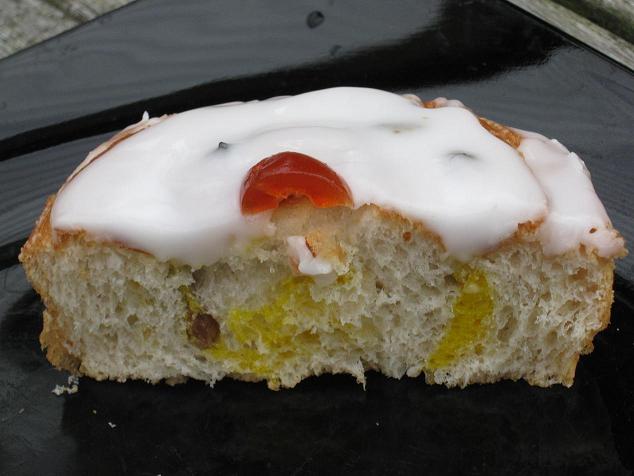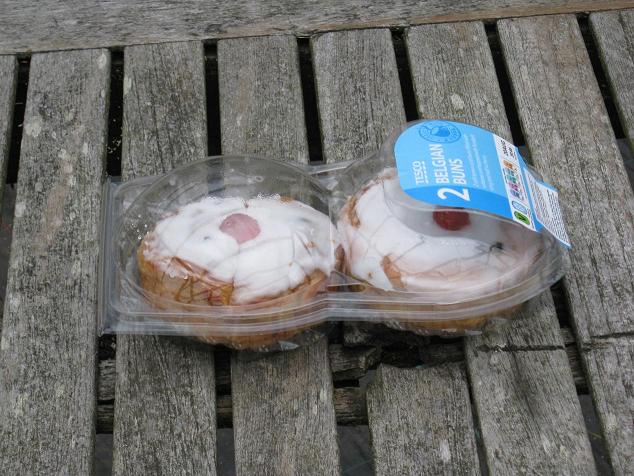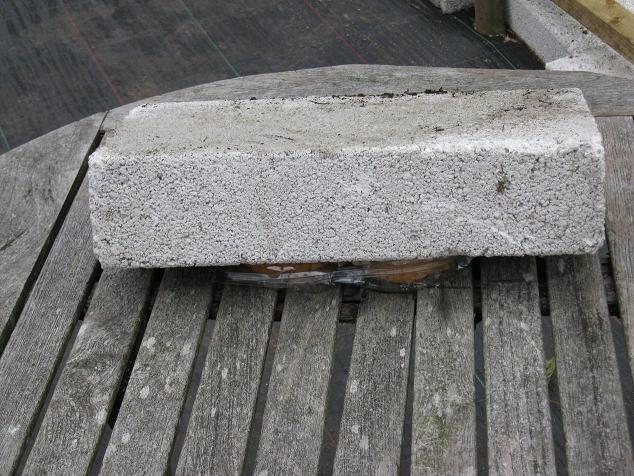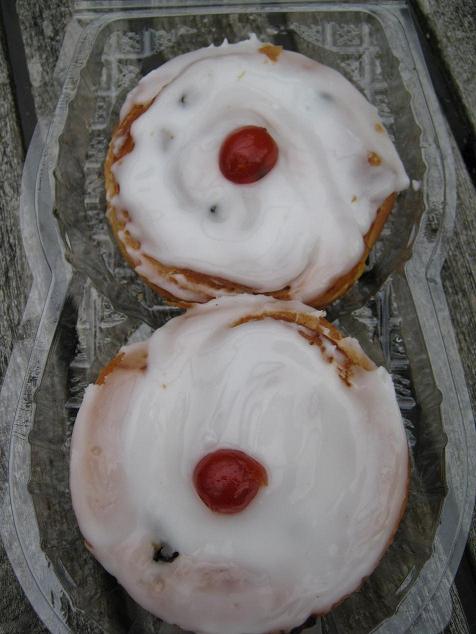

The icing is soft and very sticky. It is sweet, bland, slightly gelatinous and still liquid, though very thick. Unlike many buns, the icing on this one has not been dried so it is a complex and messy object to handle. It is packaged in a plastic blister, which helps to protect it and ensure that it arrives at snack-time in good condition.
There is sure to be an icing machine that inverts and dips the baked buns, or trails a curtain of liquid icing, or better still perhaps, fires a blob of icing
at it from an icing gun - Oh I want one of those, actually I think I want that job!
I haven't managed to work out how they get the cherry on the top. Lets face it,
glace cherries are not the easiest things to work with, and I have never seen one out of place. Perhaps there is a laser guided machine that picks
and positions the little buggers, but I think it is more likely that there is a person somewhere whose job is to place the cherries on the top of
Belgian Buns. A professional encherrynator! They probably wear blue nitrile gloves and have a cherry quota to meet every day.
I have been building a greenhouse, and this was a nice afternoon snack with a cup of tea. The stickiness of the bun was a little tiresome. I had to wash my hands immediately after eating it, to get the sticky icing off.
 The bun was doughy, with a slightly firm pastry bite.
The bun was doughy, with a slightly firm pastry bite.
The coiled pastry was smeared internally with bright yellow. It is described on the packaging as lemon curd, but it wasn't noticeably lemony and was the sort of yellow that would be stylish on a canary but rather frightening on a lemon.
The whole bun was slightly drier
and more flaky than expected.
Initially there seemed to be rather few sultanas wrapped within the coils and I estimated them at six per bun by external examination. Detailed dissection of a bun revealed a different story. In all there were 28 sultanas in the dissected specimen, concentrated in two large clusters hidden within the body of the bun, with a small scattering of individuals throughout the rest of the bun. The cherry on the top was rich red, rather unnatural and glowing but very appealing.
 The package of two buns were on special offer at 80p and were perfectly serviceable without being inspiring.
The package of two buns were on special offer at 80p and were perfectly serviceable without being inspiring.
The packaging informs me that each bun contains:
385 calories (19% of the guideline daily amount).
46.1g of sugar (51% of the guideline daily amount).
10.7g fat (15% of the guideline daily amount, of which 4.1 g were saturated fat, 21% of the guideline daily amount).
0.5g salt (8% of the guideline daily amount).
It is suitable for vegetarians and can be frozen. They say that they cannot guarrantee that the ingredients do not contain nuts, but that the recipe does not contain nuts, and the buns are manufactured in a factory that contains no nuts, which is ironic in the context of this review!
In this case, the buns had a 24 hour sell by date.
 In the case of the Tesco Belgian Bun, it comes packed in a protective plastic container, and it seems reasonable to conduct the durability test
on the buns while still within their purpose built packaging.
In the case of the Tesco Belgian Bun, it comes packed in a protective plastic container, and it seems reasonable to conduct the durability test
on the buns while still within their purpose built packaging.
Because these buns were for consumption during a greenhouse building tea break, it seemed appropriate to test them by placing a four inch concrete block
on top of them.
 The container was partially crushed by the block, and external inspection showed that the buns were relatively undamaged. On opening the package, the disadvantage
of the liquid icing became apparent. Both buns stuck to the interior of the lid and it was impossible to dislodge them with the icing intact.
The container was partially crushed by the block, and external inspection showed that the buns were relatively undamaged. On opening the package, the disadvantage
of the liquid icing became apparent. Both buns stuck to the interior of the lid and it was impossible to dislodge them with the icing intact.
